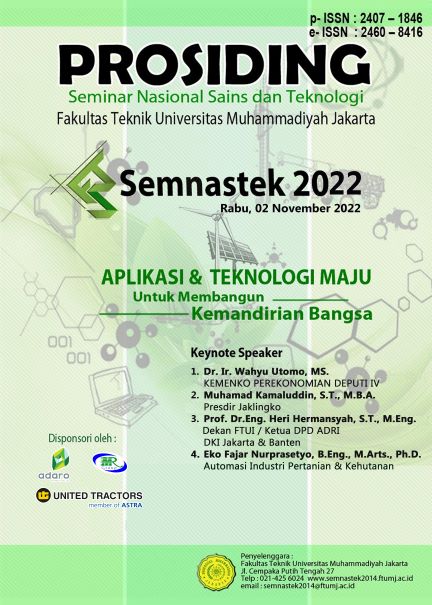KARAKTERISTIK BETON RINGAN MENGGUNAKAN FOAM AGENT (Sodium Lauryl Sulfate) SEBAGAI BUSA
Abstract
Implementasi beton sebagai bahan konstruksi merupakan elemen dominan yang digunakan dan dikembangkan dengan berbagai penelitian yang dirancang untuk mendapatkan beton yang memiliki ketahanan terhadap perubahan konfigurasi akibat gaya kerja dan pengaruh lingkungan, beton ringan umumnya memiliki berat jenis di bawah 2,0 N/mm2, penerapan foam agent dalam mortar menjadi beton ringan, bertujuan untuk mengurangi berat beton dan memiliki massa yang rendah dengan menggunakan bahan berupa sodium lauryl sulfate yang telah diekspansi menjadi busa pada campuran mortar apa adanya. Diketahui bahwa penerapan material konstruksi bermassa rendah akan mengurangi berat struktur yang tentunya akan mempengaruhi konstruksi secara keseluruhan. Sehingga potensi penggunaan material konstruksi bangunan yang ringan dan ramah lingkungan merupakan salah satu upaya untuk mendukung konstruksi dan mendukung program pemerintah dalam meminimalisir eksploitasi material alam. Campuran beton dan karakteristik kuat tekan beton silinder 100 mm x 200 mm dengan kuat tekan rata-rata 5,702 MPa, kuat tarik diperoleh 0,522 MPa, modulus elastisitas 3,823 MPa dan kuat lentur balok 1,232 MPa. Penelitian eksperimental untuk mengetahui karakteristik kekuatan beton ringan berbahan busa mengacu pada Standar Nasional IndonesiaReferences
Amran, Y. H. M., Farzadnia, N., Ali, A. A. B., 2015. Properties and application of foamed concrete: a review. Construction and Building Materials, 101:990-1005 https://doi.org/10.1016/j.conbuildmat.2015.10.112
Bondi, C. A. M., Marks, J. L., Wroblewski, L. B., Raatikainen, H. S., Lenox, S. R., Gebhardt, K. E., 2015. Human and environmental toxicity of sodium lauryl sulfate (SLS): Evidence for safe use in household cleaning products. Environmental Health Insights, 9:27-32 https://dx.doi.org/10.4137/EHI.S31765
Dawood, E. T., Mohammad, Y. Z., Abbas, W. A., Mannan, M. A., 2018. Toughness, elasticity and physical properties for the evaluation of foamed concrete reinforced with hybrid fibers. Heliyon, 4:e01103 https://doi.org/10.1016/j.heliyon.2018.e01103
Cong, X., Qiu, T., Xu, J., Liu, X., Wang, L., Wang, Y., Chen, C., Zhao, L., Xing, C., Tan, Y., 2022. Study on the effectiveness of fibre reinforcement on the engineering performance of foamed concrete. Case Studies in Construction Materials, 16:e01015 https://doi.org/10.1016/j.cscm.2022.e01015
Falliano, D., Restuccia, L., Ferro, G. A., Gugliandolo, E., 2020. Strategies to increase the compressive strength of ultra-lightweight foamed concrete. Procedia Structural Integrity, 28:1673-1678 https://doi.org/10.1016/j.prostr.2020.10.141
Falliano, D., Restuccia, L., Ferro, G. A., 2022. Increase the fracture energy of foamed concrete: two possible solutions. Procedia Structural Integrity, 39:229-235 https://doi.org/10.1016/j.prostr.2022.03.092
Gencel, O., Bayraktar, O. Y., Kaplan, G., Benli, A., Barrera, G. M., Brostow, W., Tek, M., Bodur, B., 2021. Characteristics of hemp fibre reinforced foam concretes with fly ash and taguchi optimization. Construction and Building Materials, 294:123607 https://doi.org/10.1016/j.conbuildmat.2021.123607
Karthikeyan, B., Selvaraj, R., Saravanan, S., 2015. Mechanical properties of foam concrete. International Journal of Earth Sciences and Engineering, ISSN 0974-5904, Volume 08, No. 02, pp. 115-119 https://www.cafetinnova.org
Kearsley, E. P., Wainwrigth, P.J., 2002. The effect porosity on the strength foam concrete. Cement and Concrete Research, 32: 233-239
Kramer, C., Schauerte, M., Kowald, T. L., Trettin, R. H. F., 2015. Three phase foams for foam concrete application. Material Characterization, 102: 173-179 https://doi.org/10.1016/j.matchar.2015.03.004
Liu, H., Li, J., Lu, Z., Jiang, J., Li, T., 2019. Effect of nanoparticles on foaming agent and the foamed concrete. Construction and Building Materials, 227:116698 https://doi.org/10.1016/j.conbuildmat.2019.116698
Liu, T., Shi, G., Li, G., Wang, Z., 2019. Lightweight foamed concrete with foam agent addition. Material Science and Engineering, https://doi.10.1088/1757-899X/490/3/032033
Nassar, R. U. D., Memon, S. A., 2018. Characteristics of foam concrete produced from detergent used as foaming agent. International Journal of Applied Engineering Research, ISSN 0973-4562, Volume 13, Number 20, pp. 14806-14812 https://www.ripublication.com
Raj, A., Sathyan, D., Mini, K. M., 2019. Physical and functional characteristics of from concrete: a review. Construction and Building Materials, 221:787-799 https://doi.org/10.1016/j.conbuildmat.2019.06.052
Ranjani, G. I. S., Ramamurthy, K., 2010. Analysis of the foam generated using surfactant sodium lauryl sulfate. International Journal of Concrete Structure and Material, Vol. 6 No. 1 pp 55-62 https://dx.doi.org/10.4334/IJCSM.2010.4.1.055
Syahrul., 2022. Kinerja beton mengandung agregat kasar daur ulang limbah bongkahan beton. Jurnal Riset Rekayasa Sipil Universitas Sebelas Maret, ISSN: 2579-7999 Vol. 6 No. 1 https://dx.doi.org/10.20961/jrrs.v6i1.63206
Syahrul., Tjaronge, M. W., Djamaluddin, R., Amiruddin, A. A., 2021. Flexural behavior of normal and lightweight concrete composite beams. Civil Engineering Journal, E-ISSN: 2476-3055; ISSN: 2676-6957 Vol. 7, No. 03 https://dx.doi.org/10.28991/cej.-2021-03091673
Suchorzewski, J., Nikta, M., 2022. Size effect at aggregate level in microCT scans and DEM simulation-splitting tensile test of concrete. Engineering Fracture Mechanics, 264:108357 https://doi.org/10.1016/j.engfracmech.2022.108357
Yan W., Cui W., and Qi L. (2020). Effect of aggregate gradation and mortar rheology on static segregation of self-compaction concrete. Construction and Building Materials, 259:119816, https://doi.org/10.1016/j.conbuildmat.2020.119816.
Yaseen, Z. M., Deo, R. C., Hilal, A., Abd, A. M., Bueno, L. C., Sanz, S. S., Nehdi, M. L., 2017. Predicting compressive strength of lightweight foamed concrete using extreme learning machine model. Advances in Engineering Softwear, https://dx.doi.org/10.1016/j.advengsoft.2017.09.004

